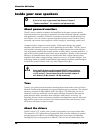
About the M1 Active
M1 ACTIVE REFERENCE MANUAL 13
The cabinet and port design
The M1 Active cabinet construction employs vinyl composite material laminated to a
.625” MDF (medium density fiberboard) core for the four sides and the rear. The
front panel is 1” thick MDF, to withstand the greater demands of the drivers
mounted on it. The entire cabinet is braced extensively in random fashion to
dissipate intramodal vibration.
Why the tweeters are offset
The M1 Active speakers have been developed as a mirror-imaged pair with dual
front mounted ports and an offset tweeter. In some applications, an extremely wide
dispersion tweeter, such as used in the M1 Active, will exhibit response dips if
mounted exactly on center. Wave-guide style tweeters, used in other products,
purposely limit dispersion and thus can be center mounted. But as hi-end audiophile
speaker companies have found, a high quality dome tweeter, offset in the cabinet
toward the stereo “image center” (between the left and right speakers) will have a flatter
characteristic frequency and power response. This (flat power response) more closely
characterizes the way humans hear.
On a horizontal polar response curve of the M1 Active, with the cabinet placed
vertically, the tweeter response at one meter stays essentially symmetrical on either
side of the cabinet’s centerline. This is because the angle subtended between the
cabinet-centerline-to-tweeter-centerline (.5”), and the nominal nearfield listening
distance (1 meter or 39.375”), is only 1.27 degrees. Thus, acoustically speaking, the
offset tweeter design has no negative effects, only the positive of smoothing the
frequency response in the 2KHz-4KHz range.
In the tradition of the Alesis Superport design, which uses the energy from the back
of the speaker to enhance bass performance, the M1 Actives use dual, front baffle
mounted, long folded ports. The dual ports on the M1 Active are also non-
symmetrical with relation to their distances from the woofer. In developing the M1
Active, Alesis engineers determined that dual ports, offset to the outside of the stereo
image center gave the most coherent and extended low bass augmentation. The
ports are flared on the front baffle to provide smooth and quiet exit airflow while
inside they are cut with a 45° angle and faced toward the amplifier’s internal heat
sink. This arrangement aids in keeping the internal amps working at a more constant
temperature. At the same time, this 45° angle increases the port’s air entry efficiency.


















